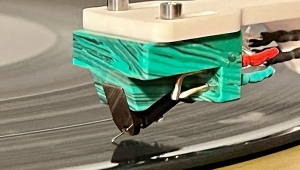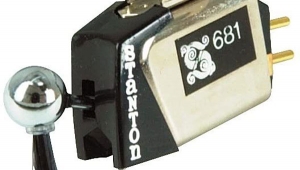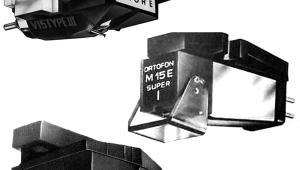| Columns Retired Columns & Blogs |
Ortofon MC-2000 MC phono cartridge
Although the idea of a $1000 moving-coil cartridge no longer shocks audiophiles, it is still not exactly what I'd call "Mainstream Hi-Fi." Audio magazine's 1984 Equipment Directory—the most complete such compendium published in the US—lists only 10 models in this price range, not counting the Kiseki Lapis Lazuli at a whopping three-and-a-half grand! I have not tested most of these, nor have I tried any of the current models from the Japanese Koetsu firm, which was first with the gall to put a $1000 price tag on a cartridge. But I have tested a couple of one-granders during the past few years, and was sufficiently unimpressed to be hesitant about testing any more samples of what were beginning to look like nothing more than monumental ripoffs. So when Ortofon sent us the MC-2000, I was naturally less than enthusiastic about trying it.
Footnote 1: Not so, according to Contributing Editor Steve Watkinson: fellow Scandinavians Electrocompaniet make a pre-preamp especially for the typically low output Ortofons. An example has been received in Santa Fe and will be duly reported on.—Larry Archibald
 I'll say one thing, though: the MC-2000 sure looks as if it's worth the money. Its packaging—or should I say, its presentation—is luxurious. It comes packed in a black-finished wooden box with rabbeted joints, no less, and brushed aluminum latches. The inside is lined with a dark-blue velvet-like material, and has a 1iftup hinged panel on. top of which nest the cartridge, an Ortofon headsheil, and a "certificate" listing quality-control measurements on the enclosed cartridge. Under that, nested in their own upholstered recesses, are a handsome aluminum screwdriver (an important item, as we shall see later), a matching stylus cleaner, a tracking-force gauge (calibrated in milliNewtons—how en1ightening!), and a plastic vial of cartridge mounting hardware, all imprinted with the Ortofon logo. All that's missing is a little brass plaque with the buyers name hand-engraved on it in florid cursive. Now that's luxury—or, as they say on commercial TV, "lugzhury." Still, I couldn't help but wonder: how much could the MC-2000 be sold for in a plain-Jane plastic box with the cheap-but-adequate accoutrements provided with other cartridges?
I'll say one thing, though: the MC-2000 sure looks as if it's worth the money. Its packaging—or should I say, its presentation—is luxurious. It comes packed in a black-finished wooden box with rabbeted joints, no less, and brushed aluminum latches. The inside is lined with a dark-blue velvet-like material, and has a 1iftup hinged panel on. top of which nest the cartridge, an Ortofon headsheil, and a "certificate" listing quality-control measurements on the enclosed cartridge. Under that, nested in their own upholstered recesses, are a handsome aluminum screwdriver (an important item, as we shall see later), a matching stylus cleaner, a tracking-force gauge (calibrated in milliNewtons—how en1ightening!), and a plastic vial of cartridge mounting hardware, all imprinted with the Ortofon logo. All that's missing is a little brass plaque with the buyers name hand-engraved on it in florid cursive. Now that's luxury—or, as they say on commercial TV, "lugzhury." Still, I couldn't help but wonder: how much could the MC-2000 be sold for in a plain-Jane plastic box with the cheap-but-adequate accoutrements provided with other cartridges?
This cartridge's compliance is extraordinarily high for a MC. It is in fact rather too high for the cartridge's 11-gram weight. Assuming that compliance figure to be correct (and I suspect it is, if anything, low), the LF resonance in a 6-gram arm—about as low-mass as one can get—will be around 8.6Hz, which is getting well down into the warp interference range. Using Ortofon's 11-gram headshell, even in an arm having zero effective mass, would put the LF resonance at 7.8Hz, right smack in the middle of the worst pinchwarp range, with an ironclad guarantee of severe subsonic disturbances from warps. Thus, this cartridge should not be used with the high-mass arms which are so popular with MC enthusiasts. Low, low, low is the way to go!
Output, on the other hand, is lower than I have ever encountered from any cartridge that wasn't defective. At a ridiculous 0.05mV (50µV), there is no preamp with high-enough gain to accept this directly. In fact, there are probably zero head amps made that are quiet enough to be used with this cartridge, either, and that includes the MC inputs on preamplifiers (footnote 1). You must use a transformer and few of those out there are going to have enough voltage step-up for the MC-2000, You are pretty much obliged to use Ortofon's own T-2000—a veritable brick of a transformer, weighing almost 8 lbs!—which is (naturally) designed to be used with this cartridge And that, folks, costs another S1000. We are talking big bucks here.
Installation
Installation of the MC-2000 can be simple and easy, or a pain in the butt, depending. First of all, it is essential that one use the non-magnetic screwdriver supplied with the MC-2000, as the cartridge has an absolutely fierce magnetic field radiating outwards for a good half inch from its body! Any ferrous object brought within that distance will cause the cartridge to fling itself bodily at the object and hold on tenaciously, at high risk to the stylus assembly. It should not be necessary to mention that if you still own a turntable with a steel or cast-iron platter, you should not even consider buying an MC-2000—unless you use a very fat platter mat or have a perverse compulsion to track discs at 50 grams downforce. This magnetic attraction is not unique to the Ortofon; it's just that most other MCs have far less of it.
The mounting-screw holes at the sides of the cartridge are deeply countersunk from the underside and will swallow up the nuts provided with the cartridge, making it almost impossible to prevent a nut from turning with the screw when you try to tighten it. Things go much more easily if you insert the screws from the bottom of the cartridge and put the nuts at the top of the headshell. In most cases the only drawback to this is cosmetic: nuts, and a short length of protruding thread, don't look as good as a pair of screw heads. But with some arms and some unusually designed headshells, clearance above the screw holes atop the headsheil is critical, and the permissible limit may be exceeded when the mounting screws are installed heads-down.
There are two possible solutions to this: use shorter mounting screws (most of us have a small collection of assorted cartridge hardware, arid dealers usually have a large collection), or drop a pair of spacers under the screw heads. Two spacers are supplied, and if you're lucky) those may just happen to be the right thickness.
At this point, I must comment on Ortofon's tracking-force gauge. Bleccch! I tried two of them: both had so much pivot friction that it was very difficult to take a reading from a conventional tonearm (you must "come at" the balance point from opposite directions, several times, and average the readings), and absolutely impossible with a viscous-damped arm! My advice is to chuck Ortofon's gauge and use a real one to adjust tracking force. (Incidentally, Shure's gauge won't work properly with the MC-2000 either, because its balance beam has enough ferrous content to grab hold of the cartridge and scrunch the stylus flat! You need a gauge that has high accuracy, low friction, and no ferrous metal parts near the cartridge. I wish you luck finding one. (I am fortunate to own one of the old Weathers gauges (footnote 2), which meets all three requirements. Audiotex [no longer in business] used to sell a version of it, and may still.)
So what do you get for your $2000?
First of all, you get extraordinary tracking ability across the entire audio range. The Shure V-15s no longer hold a monopoly on incredible trackability! Beyond that, I can only say that the MC-2000, like all such very low-output cartridges, is at the mercy of the step-up device. Since you will probably (or should) mate this with its own transformer, most of the following comments apply to its use with that transformer.
I will now state that the MC-2000 is the best-sounding moving-coil cartridge I have ever heard! The clincher, for me, was the way it reproduced the violins on Wilson Audio's Beethoven/Enescu (Enesco) disc and the Sheffield Strauss and Dvorak disc. The high end on these discs was as natural as I have ever heard—open, airy, delicate, and yet with the real bite of an actual fiddle. (They are two different kinds of fiddle: the Wilson Audio record has a warm, mellow Guarnerius, the other a classic Stradivarius—clear and pure but with more edge and bite.)
Footnote 1: Not so, according to Contributing Editor Steve Watkinson: fellow Scandinavians Electrocompaniet make a pre-preamp especially for the typically low output Ortofons. An example has been received in Santa Fe and will be duly reported on.—Larry Archibald
Footnote 2: For the benefit of you infants out there, Weathers Industries made the first, and probably the last, commercially practical FM pickup system during the early '50s. It was mono; Weathers could never get the stereo version to work.—J. Gordon Holt
- Log in or register to post comments



































